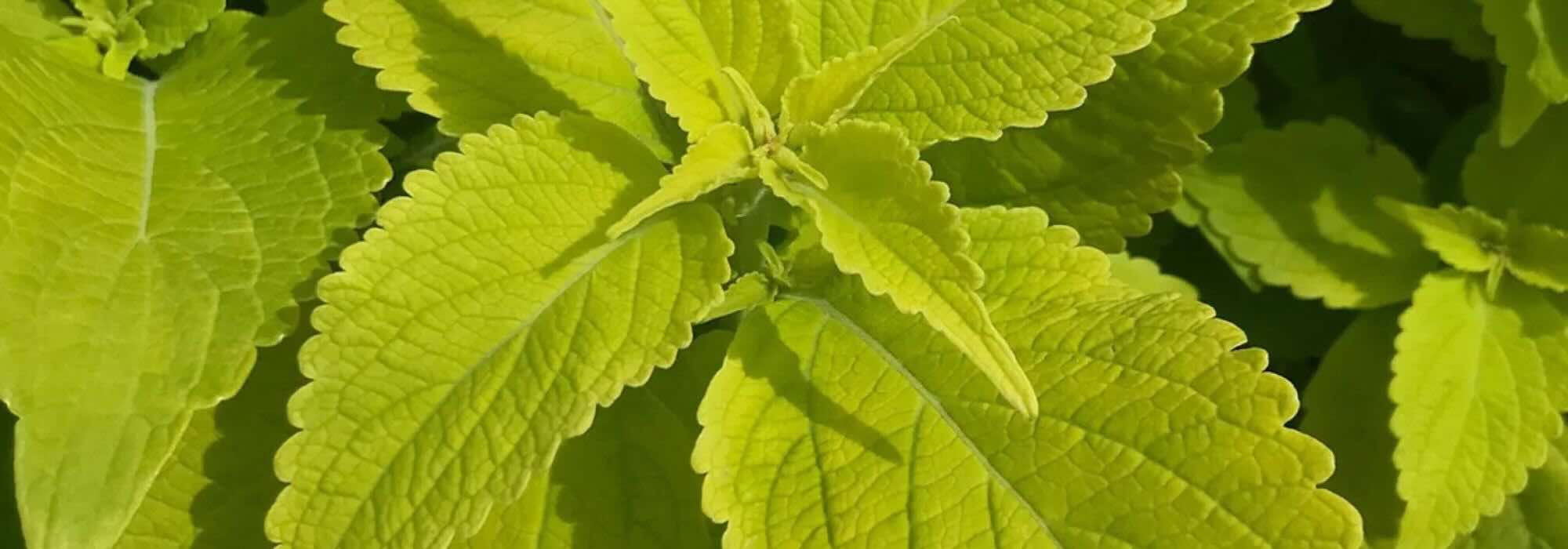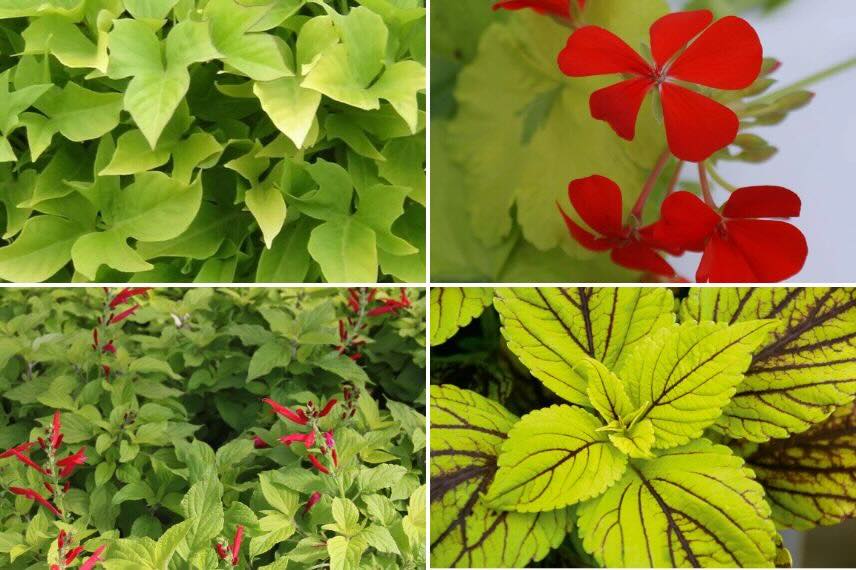
Golden Foliage: Annual Plants That Brighten the Garden All Season Long
Our selection and advice
Contents
The golden foliage is the garden’s light asset. Bright yellow, chartreuse green or subtly gilded, it catches the eye, creates contrast and energises compositions, even in the absence of flowers. Easy to grow, the annuals with golden foliage are ideal for experimenting with new combinations each season. In pots, flower beds or borders, they bring warmth and originality from spring onwards. In this article, discover a selection of luminous varieties, tips for integrating them harmoniously into your designs, and simple tricks for successful care.
Why choose golden-leaved plants?
Golden foliage is like a ray of sunshine in leafy form. In a garden or on a balcony, these plants instantly brighten up the space, even the dullest corners. The advantage of golden foliage is that it doesn’t rely on flowering to be spectacular—it shines from spring to autumn, without interruption.
Light and Radiance
Golden or chartreuse hues (that lovely bright yellow-green) catch the light like no other. In slightly shaded areas of the garden, they create a sense of brightness and naturally draw the eye. It’s a great way to “light up” a gloomy corner or highlight a container display.
Contrast and Enhancement
Golden foliage is perfect for creating contrast. You can pair it with plants featuring purple, silver, or dark green leaves for an instantly eye-catching effect. They also work beautifully with brightly coloured flowers like violet, blue, or red to create a true natural spectacle!
Originality and Movement
In a world dominated by green, golden foliage stands out and catches the eye. And when it comes to annuals, have fun changing them up each year—test new combinations, dare to try unexpected pairings. It’s a wonderful way to personalise your garden or balcony without too much hassle. It’s also a great way to experiment and refine your taste and talent.

The incredible luminosity of a golden-leaved Coleus (here, the superb lime yellow-green of ‘Margarita’)
Read also
10 Easy Annual Flowers to SowOur selection of golden-leaved annual plants
Coleus (Plectranthus)
The Coleus from the Copinto series, inspired by famous cocktail colours, captivate with their vibrant foliage and structured habit. ‘Margarita’ forms a compact mound of 30 x 30 cm, composed of small zesty yellow-green leaves that are strikingly bright. ‘Caipirinha’, more vigorous, displays serrated lemon-yellow foliage marked with brown-red veins, enhancing its exotic appeal. These tender plants, grown as annuals, thrive in partially shaded spots and moist soil. They are ideal for containers (even indoors) or borders, perfect for contemporary or exotic settings. Other cultivars feature bold bicolour patterns in yellow and purple, such as Coleus FlameThrower Spice Curry and Coleus Premium Sun Mighty Mosaic.
Morning Glories
The Sweet Caroline Light Green variety of ornamental sweet potato (Ipomoea batatas) forms a widely spreading dome, 30 cm tall and 80 cm wide. Its chartreuse-green foliage, deeply lobed like oak leaves, creates a striking graphic effect. Fast-growing, this tender perennial is cultivated as an annual. Perfect for planters, hanging baskets, or sunny ground cover, it’s heat-resistant and low-maintenance, instantly brightening summer displays. Also consider the Sweet Caroline Bronze cultivar, with coppery-yellow iridescent leaves.
Pelargonium or Zonal Geranium
A classic yet still beloved variety, Crystal Palace Gem forms floriferous bushes up to 60 cm tall. Its variegated foliage in chartreuse-yellow and mid-green highlights salmon-red flowers blooming from spring to autumn. Versatile, it suits small gardens, hanging baskets, and containers alike. Its luminous leaves make it ideal for energising colourful compositions.
Salvia elegans ‘Golden Delicious’
The Pineapple Sage ‘Golden Delicious’, a tender perennial grown as an annual in cooler regions, forms a handsome 80 x 80 cm bush with aromatic bright yellow foliage. A mutation of Pineapple Sage, its leaves emerge yellow-green before maturing to a dazzling golden hue. In autumn, it bears long spikes of scarlet-red flowers, creating a spectacular contrast with the golden foliage. Though not fully hardy, this robust sage thrives in well-drained, sunny soils. Ideal for borders, herb gardens, or large pots to overwinter indoors.
Successfully incorporating golden foliage into the garden
Golden-leaved plants naturally catch the eye. To make the most of them, it’s essential to position them strategically in compositions, revealing their full potential without unbalancing the whole.
Creating Contrast
Golden foliage offers a striking contrast with darker hues such as purple leaves, deep green foliage, or blue and violet flowers, like annual sages or hardy geraniums, for example. These pairings can enliven a border or container by playing with colour contrasts.
Bringing Light to Shady Areas
In darker corners of the garden, golden foliage acts like a natural spotlight. Along borders, at the base of taller plants, or in shaded spots, these bright tones visually lighten the space and draw attention.
Making the Most of Containers
Golden foliage shines brightest in pots or hanging baskets. A chartreuse morning glory cascading elegantly from a planter or a compact coleus in a dark pot creates a bold visual contrast. Plus, in containers, it’s easy to move plants around to test different spots based on light or decorative needs.
Blending into Colourful Schemes
Golden foliage pairs particularly well with vibrant summer displays, such as tropical themes or meadow-style borders. It complements exuberant flowering plants: cannas, rudbeckias, zinnias, cosmos, and ornamental grasses.
Maintaining Balance
Like any dominant colour, gold is best used sparingly. A few well-placed specimens often suffice to illuminate an entire scene. Overuse can quickly unbalance the composition and strain the eye.

Pair ‘Pineapple’ sage with exotic plants like Cannas
Care Tips for Golden-Leafed Annuals
Annual plants are often robust, but they still have a few requirements to maintain their brilliance throughout the season. A few simple steps will keep them looking beautiful and in top condition.
Choosing the Right Exposure
Most golden-leaved annual plants prefer a sunny to partially shaded position. Too much shade can dull the foliage colour, while excessive scorching sun, especially in hot climates, may cause discolouration or burns. Ideally, bright but filtered light during the hottest hours of the day is best, though some, like sage, tolerate full sun. Coleus, on the other hand, thrive in partial shade.
Regular but Moderate Watering
As with many annuals, regular watering is recommended, especially for potted plants. However, excess water should be avoided, as it can lead to premature yellowing or fungal diseases. It’s best to water when the potting mix begins to dry out on the surface.
Encouraging Branching
Pinching back young shoots stimulates branching and results in denser, more balanced plants. This technique is particularly useful for coleus, which tend to become leggy if not pruned regularly.
Providing Light Fertilisation
A light, regular application of flowering or foliage plant fertiliser helps maintain plant vigour throughout the season. Be careful not to overdo it—excessive fertilisation can harm foliage colour, especially in golden varieties.
Monitoring for Pests
Aphids, whiteflies, or spider mites may occasionally target tender foliage. Regular monitoring, particularly during warm periods, allows for prompt intervention if needed, using gentle solutions (black soap, plant-based fertilisers…).
- Subscribe!
- Contents

































Comments